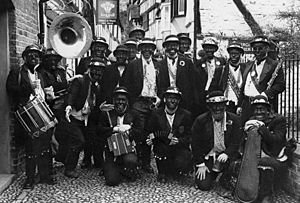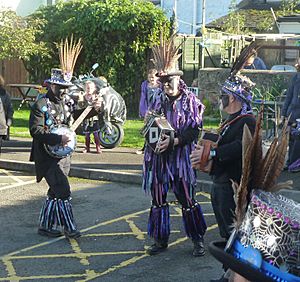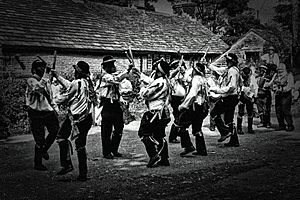Border Morris facts for kids
Border Morris is a special type of Morris dance. It comes from villages along the English side of the Wales–England border. These villages are in counties like Herefordshire, Worcestershire, and Shropshire. It's a lively and fun dance tradition.
History of Border Morris

This dance was often performed in villages during winter. People danced for fun and to earn a little money. Usually, three to twelve dancers would take part.
Some of the earliest stories about Border Morris come from a researcher named E.C. Cawte. In 1584, there were questions about "disguised persons" like Morris dancers in Shrewsbury.
A great story from 1609 describes Morris dancers at Hereford Racecourse. It mentions "two musicians, four whifflers, and twelve dancers." This group included a hobby horse and a Maid Marian. All these dancers came from villages near Hereford. The story even said that Herefordshire's Morris dance was better than almost anywhere else!
Later records mention dancers causing a bit of a fuss. In Longdon, Worcestershire, dancers were reported for disturbing the Sabbath day between 1614 and 1617. In 1652, dancers in Much Wenlock caused a disturbance in an ale house. Records from Shrewsbury also mention payments to the "Bedlam Morris" in 1688 and 1689.
The way the dance was performed could change. It often depended on how many dancers were available. Sometimes, the dances collected from one place were quite different. This shows how flexible the tradition was each year. Some groups might only have one dance. Others, like those in Malvern, had many different dance moves.
Border Morris dances often use short sticks. Sometimes, dancers use both a stick and a handkerchief. The dances usually feature a high single step. This step is similar to local country dances. It seems there were not many strict rules for starting steps or ending phrases.
Some of these village dance groups would paint their faces. There are no records of different groups dancing together. A few dances, like those from Upton-on-Severn, were quite complex. They were as detailed as Cotswolds Morris dances. But many others, like from Bromsberrow Heath, were very simple. They often had just one main move and one chorus repeated over and over.
The Revival of Border Morris
In the 1960s, E.C. Cawte suggested that these dances were a special Welsh border tradition. They came from Herefordshire, Shropshire, and Worcestershire.
Since the 1960s, the Border Morris style has grown. More dances were collected in the 1970s. People like Dave Jones and Keith Francis helped with this. The tradition is known for dancers often painting their faces black. They also wear tattered shirts or coats. There's a lot of stick-clashing and a big band.
Traditionally, the band includes melodeons, fiddles, concertinas, triangles, and tambourines. Today, bands might also have a tuba or sousaphone. You might also hear a flute or oboe.
Dave Jones and Keith Francis guided the Silurian Border Morris group. They tried to keep the traditional styles and features of the dances. In contrast, in 1975, John Kirkpatrick started a new border tradition. His group, the Shropshire Bedlams, wanted to capture the spirit of the border sides. But they did not try to copy any specific old dance. Their dances often include a lot of "whooping." This sound has become common among many other Border Morris groups.
The Original Welsh Border Morris group was founded in 1973. Keeping with the old tradition, they meet only once a year at Christmas. They dance the traditional dances of Herefordshire and Worcestershire. Many newer groups have made their dances more complex. They have added new steps, figures, and choruses.
Many dances were collected by Cecil Sharp and others. Some were even in Bacon's book. But Border Morris was mostly forgotten by modern Morris dance groups. This changed in the late 20th century. The Silurian Morris Men of Ledbury, Herefordshire, started including border dances in the early 1970s. By 1979, they danced only Border Morris. The Shropshire Bedlams started in 1975. Both groups helped bring Border Morris back to life.
The Leominster Morris group was reformed in 1988. They learned from E.C. Cawte and notes from Leominster. A former dancer, Tom Postons, remembered the dancing. He said it had "lots of bowing, hat-raising, and clashing of sticks on the ground." This helped bring back Postons' stick dance. Cecil Sharp visited Leominster in 1909. He collected tunes from a local gypsy fiddler named John Locke. The Leominster men still use several of Locke's tunes today.
Border Morris dancing was different on the Welsh side of the border. A team called Carreg-las was formed there in 1992. Carreg-las means 'bluestone' in Welsh. Bluestone is a type of rock found in the Preseli Mountains. It is said that Stonehenge was built using these stones. The Carreg-las group uses traditional Welsh and English folk and Morris dance tunes.
See also




